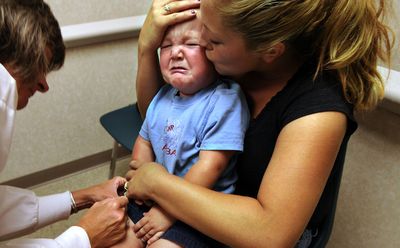Idaho lawmakers seek immunization funding
Joint panel wants Otter to restore $2.1 million he cut from budget

BOISE – Idaho already has the lowest child immunization rate in the nation, and state budget cuts that hit July 1 are making it more expensive and more difficult for Idaho families to get shots for their kids.
The collision of those two developments prompted a joint legislative committee Thursday to call for reversing the budget cuts – to the tune of $2.1 million – to restore the state’s child immunization program at least through the end of 2009. The state would have to shift the money from other Department of Health and Welfare programs, and could take the step only if Gov. Butch Otter approves.
Sen. Dean Cameron, R-Rupert, warned that the Legislature still would have to come up with money to keep the program going in January. “What the department is facing for their budget, particularly in Medicaid, in 2010 and 2011 – it isn’t pretty,” he said. But, he said, “I believe there’s actual evidence that the lack of immunization actually costs us more.”
Idaho’s child immunization rate for measles is lower than that of Indonesia, Pakistan or Croatia, according to the Idaho Division of Health, and its rate for polio is below that of Botswana, Latvia and Sri Lanka.
Idaho’s overall child immunization rate, according to the 2007-’08 National Immunization Survey, is 57.6 percent. Washington’s is 73.7 percent; the national average is 77.2 percent.
While past Idaho governors, including Phil Batt and Dirk Kempthorne, made improving the state’s dismal child immunization rates a top priority, Otter called for elimination of the vaccine program in this year’s budget, to save $2.8 million.
Sara Stover, Otter’s budget analyst for Health and Welfare, told the legislative task force, “We had to balance a budget, and we were down to nickels and dimes.”
Health and Welfare officials thought they’d be able to offset the budget cut with federal stimulus money for a year, and lawmakers approved the cut. But the federal money didn’t come through.
Washington has a similar program, and plans to end it on July 1, 2010, to save money. There, it costs the state $42 million a year.
Since 1994, Idaho has purchased vaccines for all Idaho children up to age 18, and supplied them to public health districts, doctors and hospitals. People may be charged a fee for injecting the vaccine, but the antigen itself is free. The state bought it from a federal bulk-purchasing pool that saved 30 to 50 percent off the cost of the vaccines.
Now, the only people eligible for free vaccines are children on Medicaid, those who are Native American or uninsured, or those whose insurance specifically excludes immunization coverage. Everyone else will have to pay.
The average cost to immunize a child from birth to age 18 is $4,300. Depending on a family’s insurance coverage, between deductibles, co-pays, and co-insurance, they could have to pay up to that full amount.
“I’m already getting calls from parents,” said Sen. Tim Corder, R-Mountain Home. “We already have a number of young parents who are planning not to immunize because they don’t have the money. … We really need to do something about that.”
With the state funding cut, doctors and hospitals now have to purchase the vaccines at two different prices – those for children eligible for the federal purchasing pool, and those for the kids who aren’t – and they have to account for them separately. It’s a big enough hassle and expense that many providers have stopped administering children’s vaccines at all; Russell Duke, director of the Central District Health Department in Boise, said 33 percent of providers in his district have stopped giving the shots, at least temporarily.
The result: When families go to their doctor for shots for their kids, many are being told they’ll have to pay a big price up front, or they’re being told they can’t get the shots there and are being referred elsewhere. That’s a major, identified risk factor for kids not getting all their required immunizations.
As a result, more parents are turning to public health districts for immunizations, and they have no additional funding to handle the jump.
The joint legislative task force, which includes lawmakers from both parties, voted unanimously to send a letter to Otter requesting a fund shift at Health and Welfare to reverse the immunization budget cut for the remainder of 2009.
Otter’s office said the governor wouldn’t comment until he receives and responds to the letter.
Idaho health officials said the state’s culture leads to distrust of immunizations. Also, younger parents simply haven’t seen the chronic diseases that the shots prevent. “Some actually think we’ve made them up,” Smith said.
Dr. Stephen Ryter, medical director of Blue Cross of Idaho, a pediatrician, told the lawmakers, “People don’t think these diseases exist anymore.” Yet, he said, “I’ve had a number of my patients die of meningitis.”
Idaho also has seen outbreaks of whooping cough, or pertussis, in recent years.